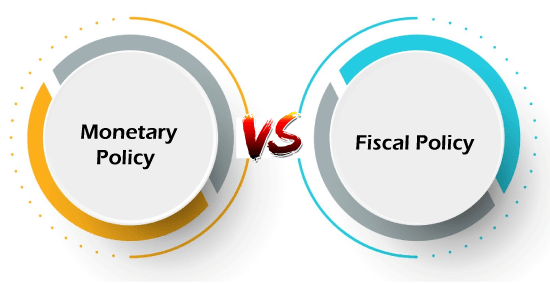Difference between Monetary Policy and Fiscal Policy
The economic structure of a nation depends upon several factors. The government of that particular nation regulates some rules and policies that have to be adhered by all the institutions. It is essential for a nation to be independent and have a strong economic stature among other countries. Inflation, growth, development, and several other factors must be kept in kind by the government before making policies and guidelines. The management of money and its regulation is an essential part of the nation.
So, how is it done? Well, the government makes two kinds of policies that are essential for running the nation. They are monetary policy and fiscal policy. The taxes, inflation, etc., are taken care of by these policies. Now, there are certain aspects of monetary policy and fiscal policy. So, let us discuss them in detail.

Monetary Policy
Monetary policy is defined as the management of the money supplied. The main purpose of the monetary policy is to meet macro-economic objectives like preventing inflation, excessive consumption, and liquidity of money. In layman’s language, monetary policy is a macro-economic policy made by the central bank. In this policy, the supply of money and the interest rates are managed by the officials. The central bank is responsible for increasing and decreasing the amount of money so that inflation, growth, etc., are managed carefully. One of the common examples of monetary policy includes the buying and selling of government securities through open markets.
Interestingly, there are three prominent tools of monetary policy, namely, open market operations, reserve requirements, and discount rates. These three tools are used for managing the supply of money. Now, there are two significant kinds of monetary policy. They are expansionary and contractionary. The contractionary policy is responsible for decreasing the circulation of money in the economy, whereas expansionary policy is responsible for increasing the money supply in the economy. The decrease in the circulation of money is achieved by selling government bonds and raising interest rates. On the other hand, the increase in the circulation of money helps in reducing the rate of unemployment.
Fiscal Policy
Fiscal policy is defined as the process through which the government manages the tax rates and government spending so that the economy is effectively managed. Fiscal policy is used by the government in different combinations to monitor the economic goals of the country. Fiscal policy also helps in the estimation of taxes and spending the might positively or negatively affect the economy.
Now, the fiscal policy has two major tools. They are government spending and taxation/ transfer of payments that influence aggregate demand. These two tools help in the estimation of money spent and taxes levied. The fiscal policy emphasizes on spending and taxes in order to influence the economic conditions. They are used for calculating the aggregate of demand for services and goods, employment, economic growth, etc.
Excessive government spending and tax cuts are some of the most significant examples of fiscal policy. Fiscal policy is important for the nation because it acts as a guiding force. It helps the government in determining the money that has to be spent on different economic activities. Well, there are three essential kinds of fiscal policy, i.e., expansionary policy, neutral policy, and contractionary policy.
Now, there are several differences between fiscal policy and monetary policy. So, let us discuss some key points regarding it.
| S.NO. | MONETARY POLICY | FISCAL POLICY |
|---|---|---|
| 1. | Monetary policy is defined as the policy in which money supplied is managed by the central bank. | On the other hand, fiscal policy is defined as the policy in which the tax rates and government spending is managed. |
| 2. | There are two types of monetary policy, namely expansionary monetary policy and contractionary monetary policy. | There are three types of fiscal policy, namely expansionary fiscal policy, neutral policy, and contractionary fiscal policy. |
| 3. | Monetary policy helps in controlling inflation, unemployment, etc. | The fiscal policy helps in determining the money spent by the government on economic activities along with the taxes levied. |
| 4. | Monetary policy is administered by the central bank. | Fiscal policy is administered by the Ministry of Finance. |
| 5. | The change in the monetary policy always depends upon the economic condition of the nation. | The fiscal policy changes every year. |
| 6. | Monetary policy is responsible for controlling banks and credit amounts. | Fiscal policy is related to revenue expenditure and government. |
| 7. | The monetary policy brings about economic stability in the nation. | Fiscal policy contributes to the economic growth of the nation. |
| 8. | The two significant tools of monetary policy are credit ratios and interest rates. | The two significant tools of fiscal policy are taxes and government spending. |
| 9. | Monetary policy has no political influence. | Fiscal policy has a political influence. |
| 10. | The exchange rate in the monetary policy improves when the interest rates are high. | Fiscal policy has no impact on the exchange rates. |
So, these are some of the contrasting points regarding fiscal policy and monetary policy. Both these policies are essential for the stability and economic growth of the nation. They both contribute to the economy in their own way, i.e., controlling inflation, unemployment, etc. Thus, monetary policy and fiscal policy are a significant part of the nation.
